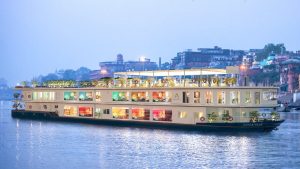Live Classes

While the Centre’s push in the sector is welcome, states and the private sector too must be brought on board. The hospitality sector is labor-intensive and can provide some of the formal jobs that a transitioning Indian economy so desperately needs
The travel, tourism, and hospitality sectors got a symbolic boost on Friday, with the Prime Minister launching the MV Ganga Vilas from Varanasi. The luxury 51-day cruise operated in partnership with private players by the Inland Waterways Authority will traverse several states, and two countries and make stops at about 50 tourist and heritage sites along the Ganga and Brahmaputra river systems. The Ganga cruise, though, should be just the beginning of tapping the unrealized potential of India’s numerous and diverse river systems for tourism. At the same time, the expansion must take into account the best practices from around India and the world, while ensuring local communities and the environment are not given short shrift.
Tourism In Travel
From Kipling’s Kim to Gandhi’s travels and the Palace on Wheels, the Railways have been essential to how travel is imagined and depicted across the Indian Subcontinent. At approximately Rs 25,000 per day per person, MV Ganga Vilas is more in line with the latter than the former. Both the PM and Shipping & Ports Minister Sarbananda Sonowal have cited the jobs that riverine tourism could bring to states like Uttar Pradesh, West Bengal, Bihar, and Assam. But employment generation must go hand-in-hand with the ecological repair.
Matter Of Concern
Two of the greatest threats to India’s river silting and pollution must be addressed for the government to realize its goal to increase cruise passenger traffic from 4 lakh people to nearly 10 times that figure. But this growth, to be sustainable, must involve local communities. While there is potential for larger, luxury liners, riverine tourism could also expand and cater to travelers from different economic strata. Also, smaller vessels may pose less of an ecological challenge.
This Is A Welcome Step
While the Centre’s push in the sector, with the PM as the face, is welcome, states and the private sector too must be brought on board. There is, for example, much that east Indian states can learn from how Kerala monetises and maintains its backwaters.
Importance Of Hospitality Sector
The hospitality sector is labour-intensive and can provide some of the formal jobs that a transitioning Indian economy so desperately needs. And given the growing global market for ecologically-conscious travel, India can if it is meticulous and enterprising in its planning — protect its rivers and create jobs at the same time.
Other Important Points
Inland Waterways Authority of India (IWAI):
National Waterway
Apart from connecting National Waterway-1 (NW-1) on river Ganges and National Waterway-2 (NW-2) on Brahmaputra, the cruise will connect 27 rivers. And the Ganges-Bhagirathi-Hooghly river system between Haldia (Sagar) and Allahabad (1620 km) was declared NW-1 in the year 1986.
Contribution of hospitality industry to the Indian economy
Download pdf to Read More